Variously spelt, the Khavad, Kavad or Kaavad is a complex storytelling artefact. It is both a shrine, a pilgrimage in a box brought to a patrons’ house through the desert wildernesses of Rajasthan and a genealogy showing the patron’s direct lineage to the gods in the stories decorating the many doors of the box.
The Kaavad tradition is around 400 years old although stories of the creation of the first Kaavad would have us believe that it is part of the mythology and was a gift from the Gods themselves. The brightly coloured, multi faceted boxes are made by the Basayati Suthars, a small tight knit community of carpenter/painters in the village of Bassi for the Kaavad storytellers (Kaavadiya Bhats) of the Mawar region of South Central Rajasthan.
The Kaavadiya Bhats make their living traveling to visit their patrons (jajmans) once every two to three years to recite the tales of the gods depicted on the shrines pointing to each scene with a ritual peacock feather quill. Each kaavad will have some kind of offertory box built in to receive donations of money while the tales and interwoven genealogies evolve.
The Kaavad in Mythstories Collection was on loan from storyteller Helen East who traveled extensively in India and brought it back from one of her trips to Rajasthan. It is most likely made for sale to the tourist trade rather than to be used by a traditional kaavad storyteller. The main focus of this box is the god Krishna, an avatar of Vishnu who came to Earth in human form, but the story panels on the box are not a simple narrative of the life story of Krishna leading to a central shrine where three 3D figures are to be found. The panels include other associated tales of gods and avatars of Vishnu such as Rama and episodes from the Ramayana. Also included amongst the pictures are depictions of the patron’s ancestors traveling on various vehicles making a direct reference to their relationship to the gods themselves.
Follow the photos below and we will try to unlock some the stories of the Kaavad, all which would be known only to its twinned teller (Kaavadiya Bhat). This is just our storytellers’ closest approximation after having worked alongside this exhibit in Mythstories museum for some twenty years. Versions of stories vary considerably from region to region so those detailed below may be slightly different to the versions told by that original Kaavadiya Bhat.
We must also acknowledge that without the seminal book “Kaavad Tradition of Rajasthan, A Portable Pilgimage” by Nina Sabnani with its appendix of “Kaavad Tales from Kojaram Rav” we would never have been able to discover a great many of the stories that are listed below.
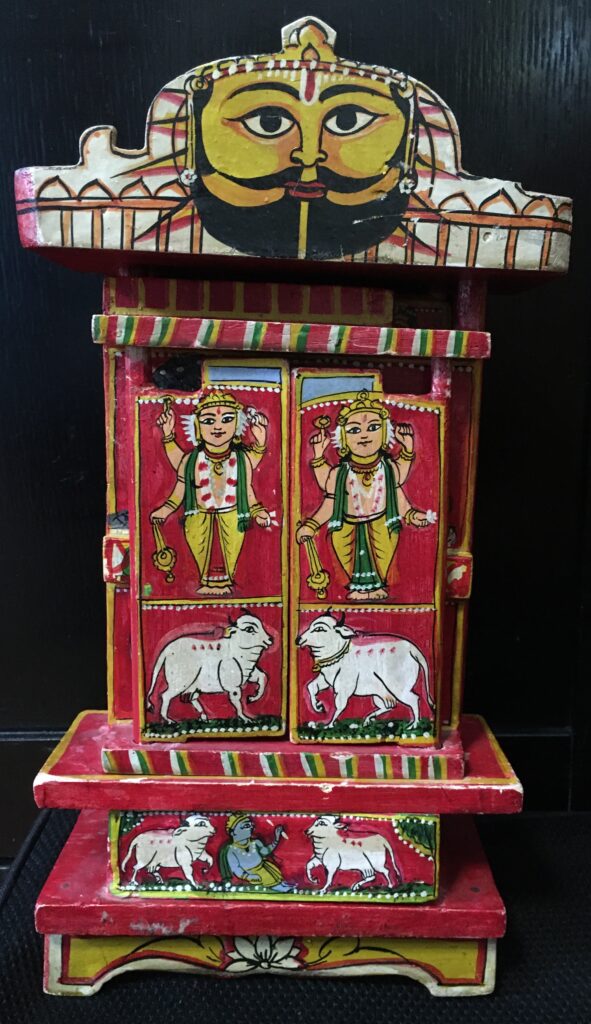
click for story details
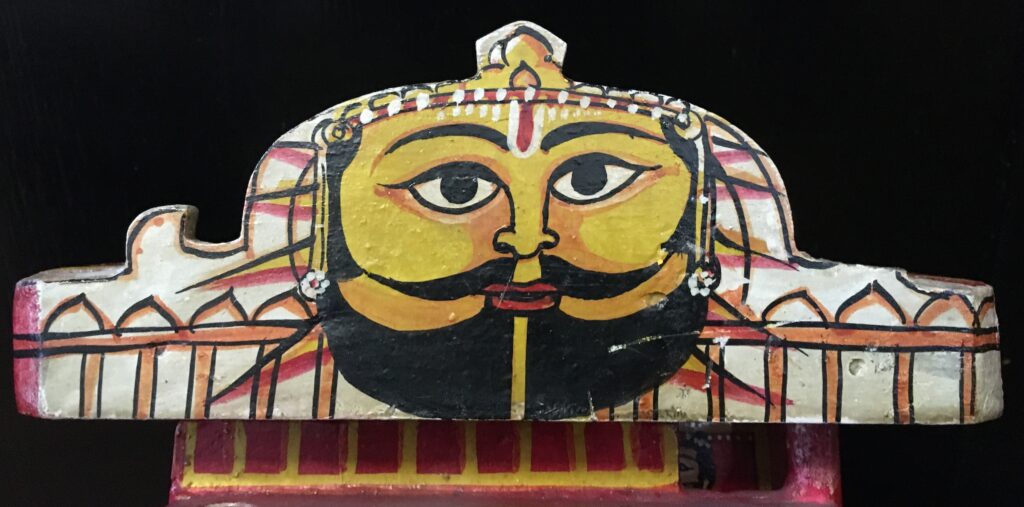
The face at the top of the Kaavad is something of a mystery, it has been suggested that it might be the storyteller himself, a sort of facial recognition system to authenticate the teller as the owner of the box. It could possibly be a depiction of the patron or one of his ancestors, or even judging from the jewelry and crown adorning the head a King or God. We haven’t been able to verify any of these possibilities.
The two figures on the “front gates to the outer shrine” are the gatekeepers Jai and Vijai who were banished to be guardians of the Kaavad by the gods because of their impure thoughts about their thirteen year old stepmother, King Sultan’s youngest wife. They are usually accompanied by two tigers but here are above two cows probably because this kaavad is dedicated to Krishna who was brought up as a cow herder.
Below is the door to the offertory ingeniously positioned so that it is always visible and available for use to take donations whichever doors or shrines are seen above. This door is decorated by an image of those same two cows with Krishna as a cow herd resting and holding his flute; as a cow herd Krishna was not a great success devoting himself mainly to pleasure, playing his flute and flirting with cow girls. This door would be opened prior to opening the doors to the outer shrine to receive donations; effectively buying a ticket for admittance. As previously mentioned it would be opened many times during the recitation of the tales on the other doors and prior to the admittance to the inner shrine, to receive more donations. The storyteller would not charge a fee but would work purely for donations.
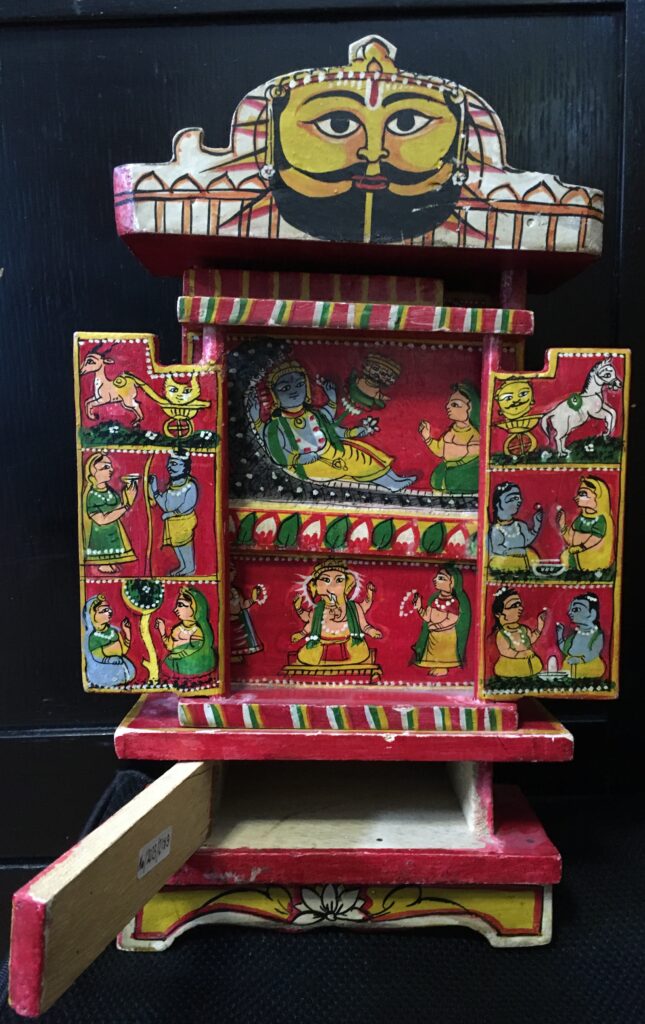
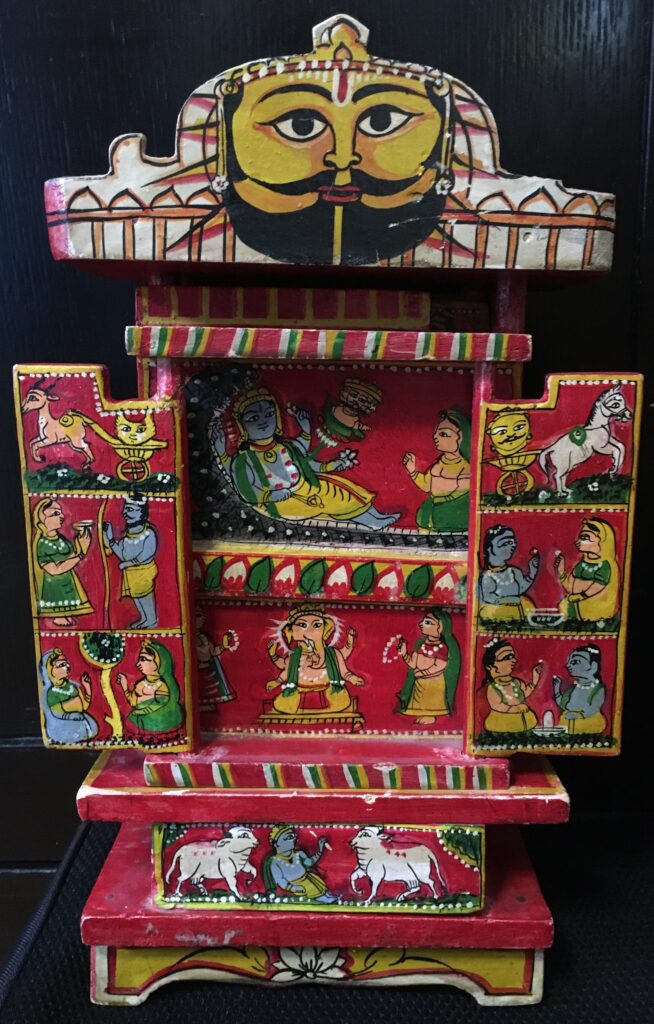
click for story details
After a donation is made the doors are opened on the outer shrine which is effectively a trailer for the full story to follow upon the opening of the main doors on the kaavad.
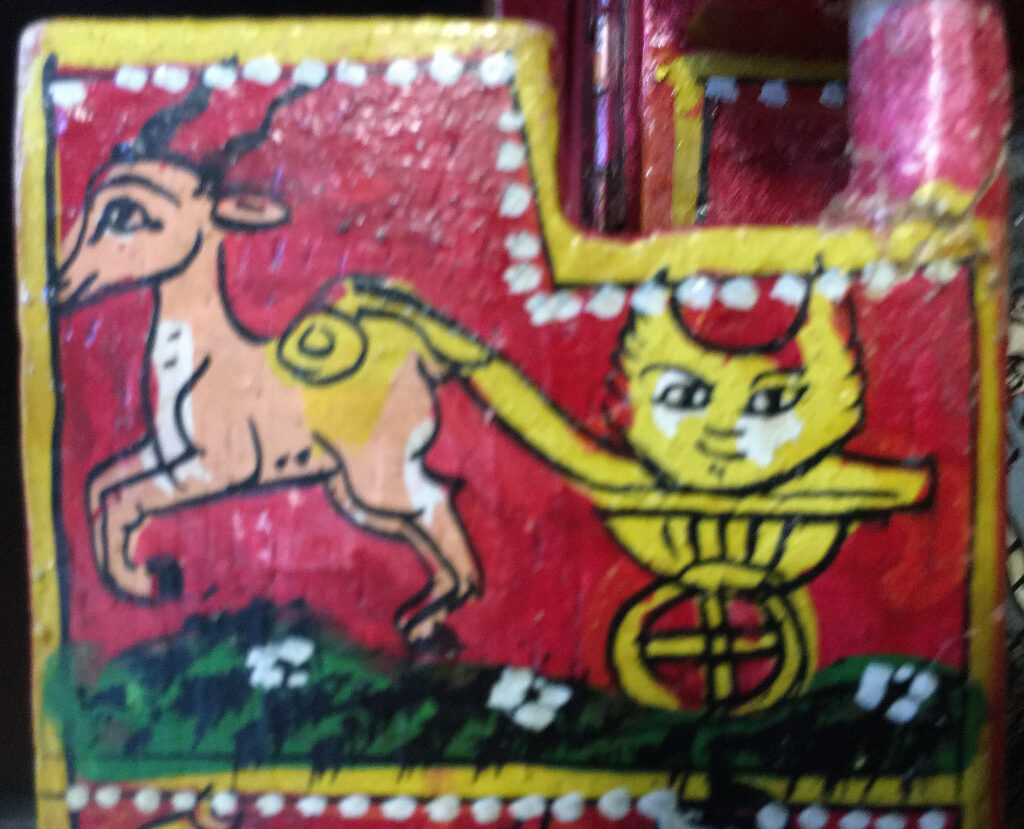
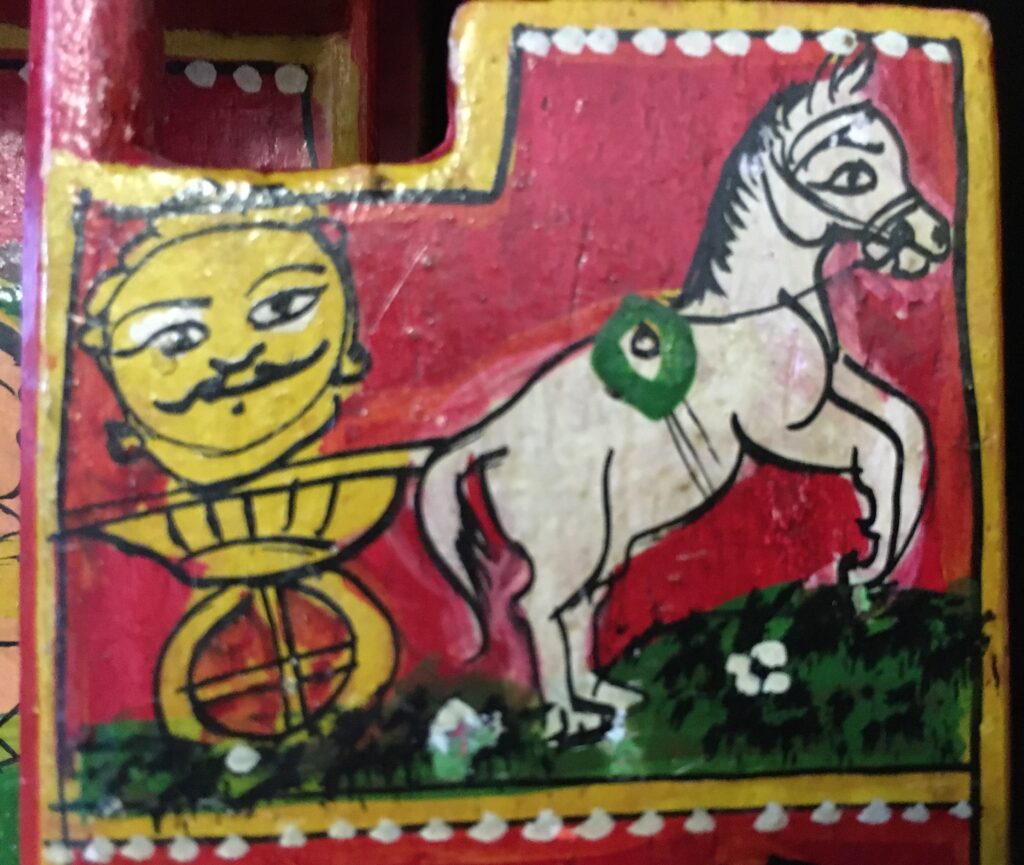
At the top of each inner door you can see the sun and moon, the sun on the right in his chariot pulled by a white horse and the moon on the left in his chariot pulled by a female blackbuck deer. The storyteller would tell the story of how they became enamored with a beautiful lady named Ahalya, a tale which resulted in the moon being hit by Ahalya’s husband, Rishi Gautum with a wet towel which to this day is visible as the dark marks on the moon’s surface.
Below on the door to the left the middle panel depicts a scene from the abduction of Sita. The blue figure here is Rama, a fellow avatar of Vishnu, he is seen in the process of drawing a protective circle around his wife Sita’s hut to protect her from the evil ten headed demon Ravana. You will find this episode elsewhere on this website at https://mythstories.com/stories/the-ramayana-part-8/ continuing to https://mythstories.com/stories/the-ramayana-part-9/ .
The lower picture panel shows an image from the story of Kunta. Kunta and her husband could not have children so she sort advice from a Guru called Durvasa. He told her to come to his garden early the next morning and to hit his mango tree with his baton and she would have as many childen as the mangoes that fell to the ground. Alas, she shared this news with her sister Godavari who was also childless and married to the King of the neighbouring land of the Kerva people. The next morning Godvari got to the mango tree first and when she hit the tree with Guru Durvasa’s stick one hundred mangoes fell to the earth. When she arrived later Kunta was greatly disappointed when only five mangoes fell to the ground, but the Guru calmed her fears when he told her that her five children would be far greater than the one hundred Kerva princes as she was purest of spirit. To prove this Kunta burned a mango seed and planted it in the ground and despite the seed being barren a mango tree grew from it.
The two picture panels on the lower part of the right inner door tell the story of Shravat who was a Bhelini (a low caste) who had devoted herself to the worship of Rama and Lakshmana (from the Ramayana). She spent her time sweeping the Dandaka forest floor waiting for Rama. When Rama and his brother Lakshmana finally arrived she could not cook for them to show her hospitality so she picked berries from her bush and to make sure they were worthy food and not sour she tasted each berry before serving them. Despite their feast being partly chewed Rama and Lakshmana could not refuse food from a devotee so ate the berries which set Shravat free from the cycle of rebirth to a low caste. It is said that Lakshmana couldn’t quite face eating half chewed berries so secreted them in his turban instead. If he had eaten them he would have been protected from Ravana’s weapons in the battle at the end of the Ramayana, however he was brought back from death by Hanuman bringing medicinal plannts to the battfield from the Himalayas which included some of the same berries from Shravat’s bush.
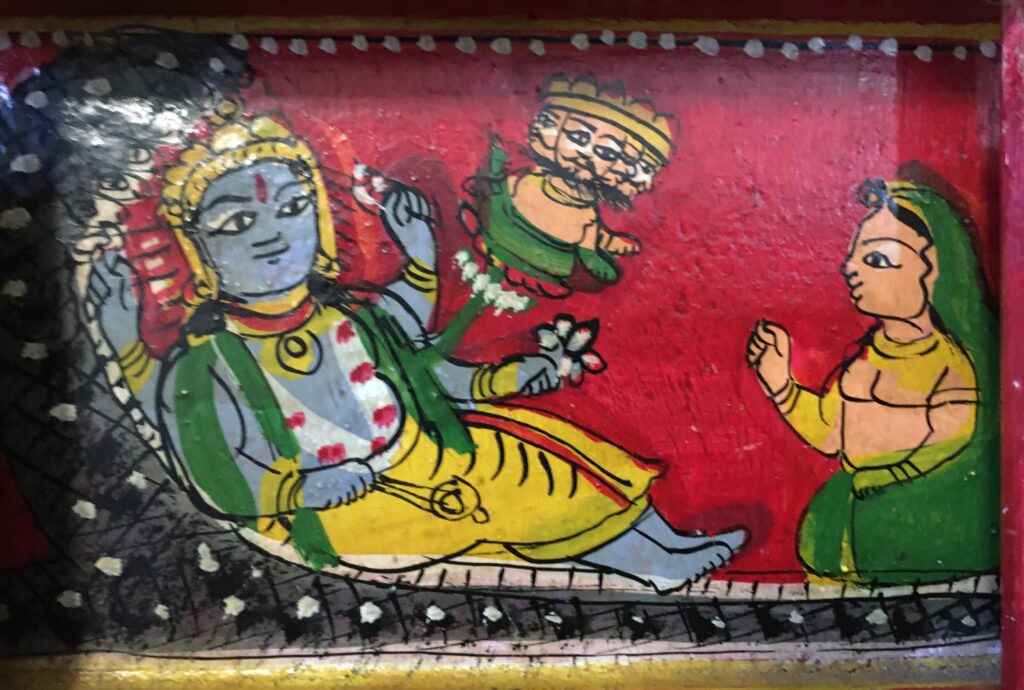
The top half of the inner panel of the shrine shows Krishna reclining on a serpent at the bottom of the ocean in his form as Dwarkadhish, or ‘King of Dwarka’. It is here that he meets Ajmal Maharaj and grants him and his childless wife the boon of a baby, or to be more exact a moustache for Ajmal Maharaj while his wife gives birth to a baby who they are told to name Bhiramdevji. They are also informed that on the next day they will find a god next to Bhriramdevji in his cot who will need no food just the offerings of incense and they should bring him up as Ramdevji.
The bottom half of the panel shows the elephant headed god Ganesha with two devotees offering garlands and prayers. Devotion should always be given first to Ganesh before the start of any story. Prayers are written to Ganesh in the pages at the start of every Hindu book. This dates back to the wedding of Rama and Sita when Ganesha was sent to represent his father Lord Shiva and was snubbed by guests who were disappointed that Lord Shiva himself was not in attendance. Ganesha was angered and sent his army of mice to undermine the road to delay the wedding vehicle. Rama then made the promise to always honour Ganesha first at the outset of any project, and an appeased Ganesha withdrew his army of mice.
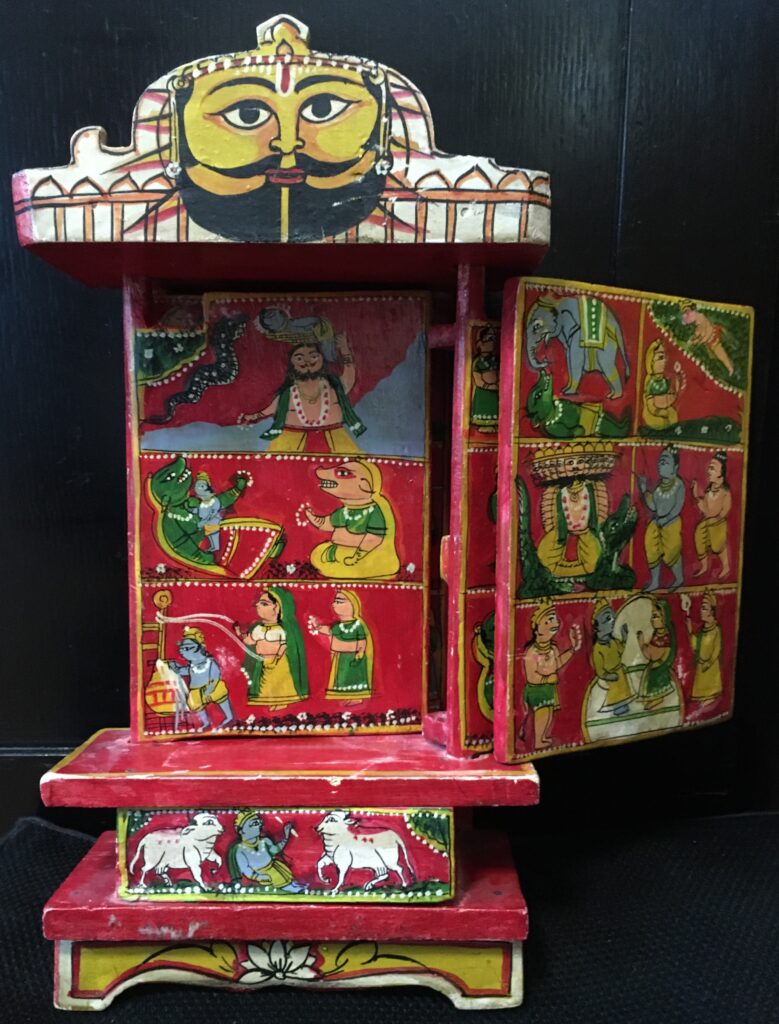
click for story details
Opening the first door of the main box we see on the cenral panel the story of the birth of Krishna. Below is a written version of the story used by Mythstories’ artist in residence in his work with schools in the late 1980’s.
The Birth of Krishna
Wise men foretold that wicked King Kansa would be killed by the eighth child born to his sister Devaki.
Secretly he had Devaki and her husband, Vasudeva, watched so the minute her eighth child baby was born it would be killed by the King’s soldiers. Kansa wanted to keep his actions secret from the Gods, but Vishnu heard of Kansa’s evil deeds and decided to come to Earth as an Avatar to be Devaki’s eighth child himself.
When the eighth child was due to be born, King Kansa imprisoned Vasudeva and Devaki. They were chained to the walls and guards stood at the door of their cell day and night.
In the middle of the night a strange calm descended upon the world. The wind ceased to blow and a full moon shone brightly in the sky. Krishna was born and a shiver of excitement vibrated around the Universe. In the heavens drums thundered wildly and Lord Indra sent a shower of flowers and raindrops to herald the birth. The Gods burst into song, “Lord Vishnu is reborn as a man and his name is Krishna”. Vasudeva held his son while the midwife slept in the corner of the cell. Outside the guards slumbered, unaware of the birth. The baby opened his eyes and the windows of heaven opened. The chains fell from Vasudeva and Devaki and the locks on the doors fell to the ground.
Knowing that the child would not be safe, Vasudeva decided to take the baby over the River Yamuna, out of King Kansa’s realm and entrust him to a cow-herd named Nanda and his wife Yasoda, both good honest people. As he waded into the river a storm blew up, the waters rose in flood. He held the baby above his head. He thought they would both drown, but Krishna called forth the Naga, the spirit of the river, who calmed the rushing waters and parted the river so the pair could cross to safety.
Vasudeva swopped Krishna with Nanda’s and Yasoda’s daughter, but soon after he returned to the prison cell King Kansa snatched the baby and crushed her against the hard stone floor. A Goddess arose from the body and told Kansa his doom was sealed, retribution awaited him.
Nanda and Yasoda loved Krishna as if he were their own. He was brought up with them like an ordinary village boy. He was naughty too, but no-one could be angry with him because of his winning ways. He teased milkmaids, stole milk and butter, and pulled cows’ tails. But all he needed to do was flash his black eyes and show his pearly teeth in a smile to be forgiven.
Yasoda was very protective and worried about Krishna until one day, when the other children ran to her saying Krishna had been eating dirt. In her anger, she ran to him and demanded he open his mouth. In his mouth she saw all creation and then she knew he would protect her, not her him. When Krishna shut his mouth she forgot everything, but her heart overflowed with love. She took him close to her and knew she would never be afraid again.
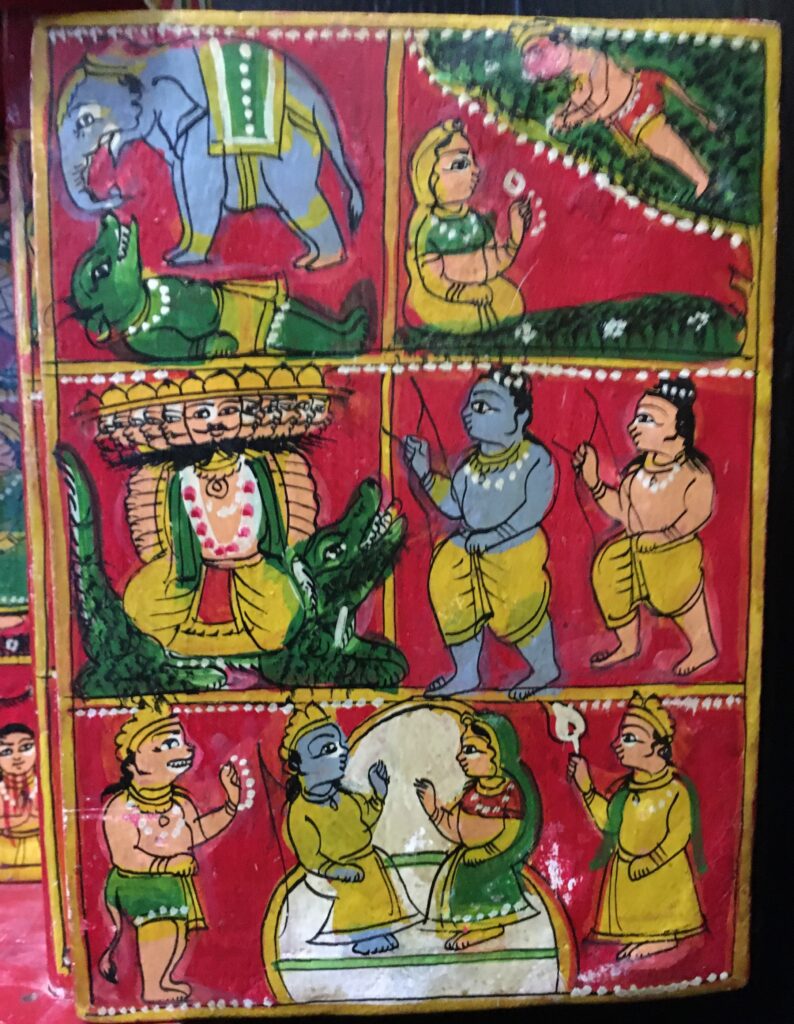
click for story details
The right hand door panel above features… top left the story of Dhapu Gujari. Dhapu was a liar and never prayed or worshipped the Gods, she led such an unholy life that she took her whole family with her to hell. Her husband, Dhaniram was freed from hell by Ganesh who jumped on his demonic form while in the form of an elephant.
The other five pictures feature (top right) Hanuman finding Sita on Ravana’s island kingdom of Lanka. Sita hands Hanuman her ring, a gift from Rama, to take back to Rama as proof of her whereabouts. The middle frames show Rama and Lakshmana battling the ten-headed Ravana riding on his crocodile.
The bottom frames show the freeing of Sita from her pavillion in Ravana’s palace garden, they are flanked by Hanuman and Lakshmana. You’ll find a fuller telling elsewhere on this website at https://mythstories.com/stories/the-ramayana-part-13/ https://mythstories.com/stories/the-ramayana-part-14/ and https://mythstories.com/stories/the-ramayana-part-15/ .
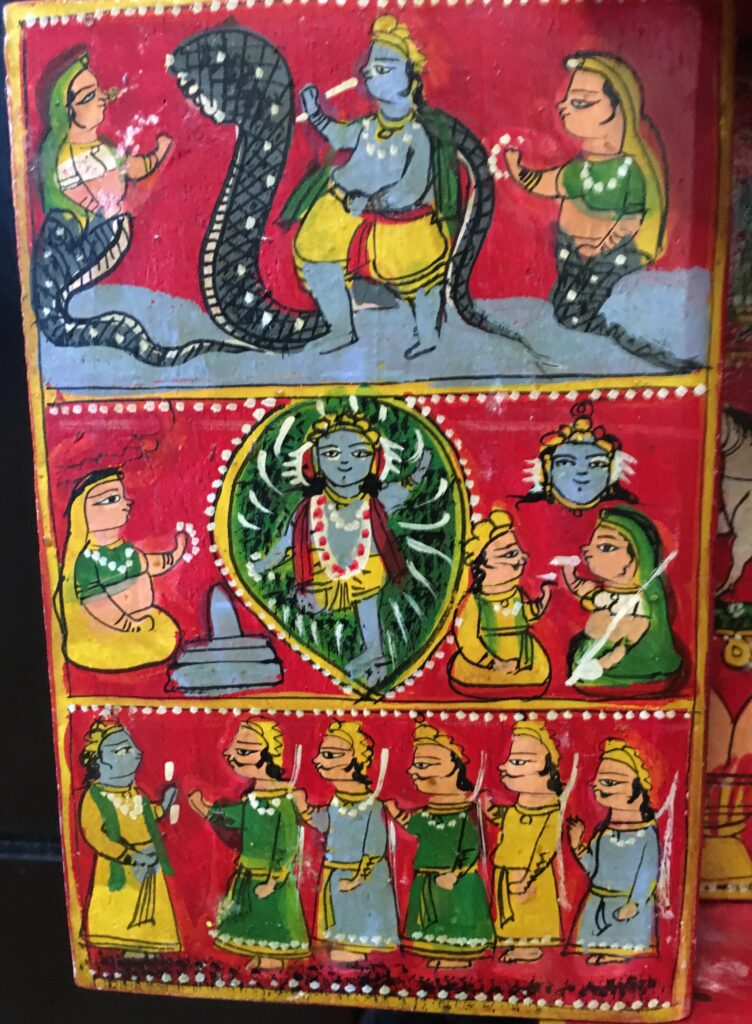
click for story details
The left hand door panel is separated into three pictures. The top picture illustrates the tale of Krishna and the Serpent, below is a short version by Mythstories’ artist-in-residence…
Krishna and the serpent
As a child Krishna killed many demons who threatened him or other cowherds.
There was once a terrible serpent (Naga) who lived in a river nearby. The beast’s fiery breath scorched the leaves off the trees and burnt any birds that flew past.
Krishna summoned the serpent by slapping his hand on the foaming waters. When the serpent appeared Krishna leapt upon his head and began to dance, he danced faster and faster forcing the snake beneath the waves.
The snake’s wives (Naginis) begged Krishna to stop and spare their husband’s life. The serpent pleaded, “I have only acted according to my nature as you created me.” Krishna took pity on him but sent him to live in the depths of the ocean where he could hurt nobody.
The middle picture illustrates the story of Krishna in a Banyan Tree. During an awful famine the people of the Earth had little choice but to commit suicide by hanging themselves from the Banyan Tree. They would write their prayers and wishes on a leaf before they hung themselves. The Gods were worried and so they sent Krishna to stop this behaviour. Krishna appeared in the Banyan Tree and sucked on his toe for sustinance which greatly impressed the people, Krishna also shrank the peoples hearts so they no longer had the courage to take their own lives.
The bottom picture shows the five sons of King Pandu being received by Krishna. This is an episode from the Hindu epic the Mahabharata. These are the five sons refered to earlier in the story of Kunta (Pandu’s eldest wife Kunti in the Mahabharata) and the sons are known collectively as the Pandavas. The Mahabharata is a massive epic and far too long to tell here it culminates in a great “just” war, an eighteen day battle where the only survivers are the Pandavas and Krishna.
Each door can be pulled back to reveal two new panels.
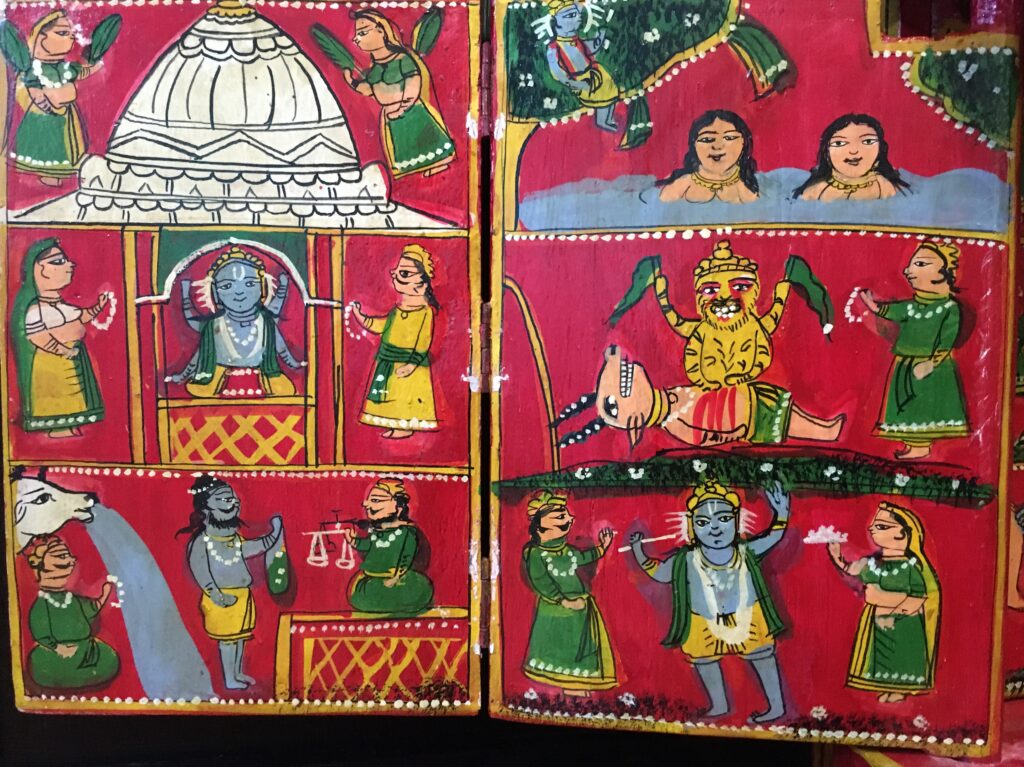
click for story details
The pulling back of the left hand door reveals the two panels above. On the top two thirds of the panel on the left you can see the Badrinath Temple with its deity Badrinarayan (another avatar of Vishnu) who went to this spot in Uttarakhand, in Northern India to meditate, hence his cross-legged posture. While he was meditating his consort Lakshmi sheilded him with the leaves of a Jujube (Indian date tree), we believe this is why the angel like devotees above the temple seem to have leaf-like wings. Badrinarayan is flanked by high status devotees. The temple in Badrinath is still a very important pilgrimage site.
The bottom third of the panel on the left shows the story of the River Ganges and how it came to Earth. The cow’s mouth depicts the source of the Bhagirathi River, one of two head-streams of the Ganges, on the Himalayan Gangotri Glacier at Gomukh, which literally translates as cow’s mouth. The character dressed in green is most likely Bhagirath, a prince who prayed devoutly for many years for the Ganges’ waters to cleanse and bless his father’s ashes. Below is a slightly different version of the story as used in schools in the late 1980’s.
Ganga Falls To Earth
King Sagrava wished and prayed with all his might to have children. He had two wives but still no offspring.
At last his prayers were answered. His first wife had a son and his second wife many. In celebration he decided to make an important sacrifice. He would offer the Gods the finest horse he could find, alas his chosen animal belonged to a God, Lord Indra. Lord Indra took his horse back before the sacrifice could be made, and King Sagrava searched in vain.
The king sent his sons in search of the horse. They looked everywhere until they began to burrow to the centre of the Earth to find the steed. Lakshmi, Goddess of the Earth cried out in pain as the sons dug deeper and deeper into the ground. Lord Vishnu heard his wife’s cries and sent a terrible fire down upon KIng Sagrava’s sons.
The King begged for his sons’ return, and so devotedly did he pray that the Gods granted his wish. The sons would return to life and go to heaven when the River Ganga flowed to Earth. So KIng Sagrava began to pray once more.
Lord Brahma allowed the Goddess Ganga, who lived in the heavenly regions of the Himalayas, to flow to Earth. The mighty River gathered in a massive torrent. Lord Shiva realised that the whole Earth would be flooded unless the River was broken up. He stood beneath Ganga as she fell Earthwards.
Ganga fell onto Lord Shiva’s head and was trapped in the curls of his hair. His hair divided Ganga up into seven rivers and sent these streaming down through the sky. Fish and turtles tumbled through the waters and white spray was all around. As the rivers hit the Earth they flowed downhill and out over the plains breaking into streams and brooks, rapids and waterfalls.
The water flowed into the parched Earth and trickled down through cracks and fisures in the rocks until they touched the ashes of KIng Sagrava’s sons. Immediately the sons sprang to life and were transported to heaven.
All who wish to be healed bathe in the River Ganges’ waters to this day.
On the top third of the right hand panel we have a depiction of the story of Krishna and the cowgirls.
This story is featured elsewhere on this website at https://mythstories.com/stories/khrishna/ together with Dez Quarréll’s painting “Surprised While Bathing”.
On the lower two thirds of the right hand panel the picture seems to depict Krishna as a young man holding a piece of land above his head where a Tiger King is clawing a demon. We cannot trace the story that would be told to this image, if you know which story it portrays please contact us.
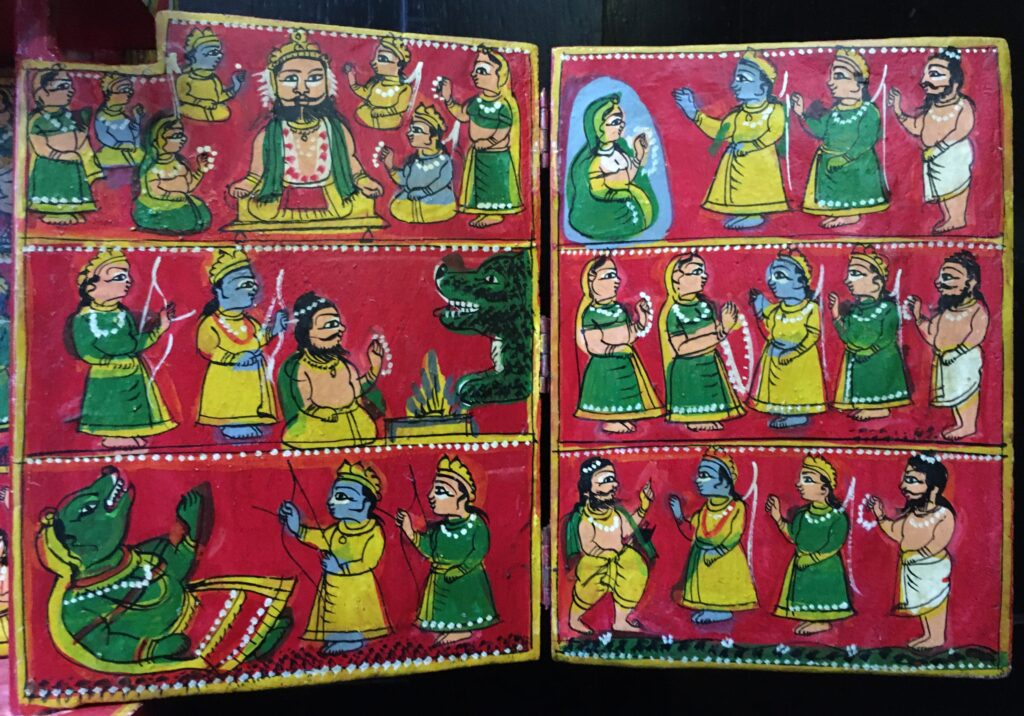
click for story details
The pulling back of the right hand door reveals the two panels above. All six illustrations feature episodes from the Ramayana with the two warriors with bows depicted being Rama and Lakshmana.
The panel on the left features on its top third King Dashrata being blessed by the birth of sons. This episode can be found elsewhere on this website at https://mythstories.com/stories/the-ramayana-part-1/
The middle picture of the left panel features a depiction of part of an episode where the young Rama and Lakshmana go to the aid of a hermit who is having his sacrifices disrupted by demons. This is a coming of age tale, with Rama and Lakshmana proving they are now men. This story can be found on the following pages of this website https://mythstories.com/stories/the-ramayana-part-2/ and https://mythstories.com/stories/the-ramayana-part-3/
The lower picture on the left panel we believe shows Rama and Lakshmana encountering Surpanakha, the sister of Ravana. This episode happens later in the epic when Rama, his wife Sita and Lakshmana are living out their exile in the Dandaka Forest. This part of the story can be found on this website on the following post https://mythstories.com/stories/the-ramayana-part-7/
The panel on the right shows more episodes from the Ramayana with Rama and Lakshama being very recognisable at the centre of all three images. However we can’t say with certainty who the man on the right with the white loin cloth is, so can’t identify the exact episodes. The top frame possibly shows Rama winning Sita as his bride. The middle image could be Rama and Sita getting married and the lower frame could be the hermit coming to Dashrata’s court to request the help of Rama and Lakshmana as illustrated opposite middle.
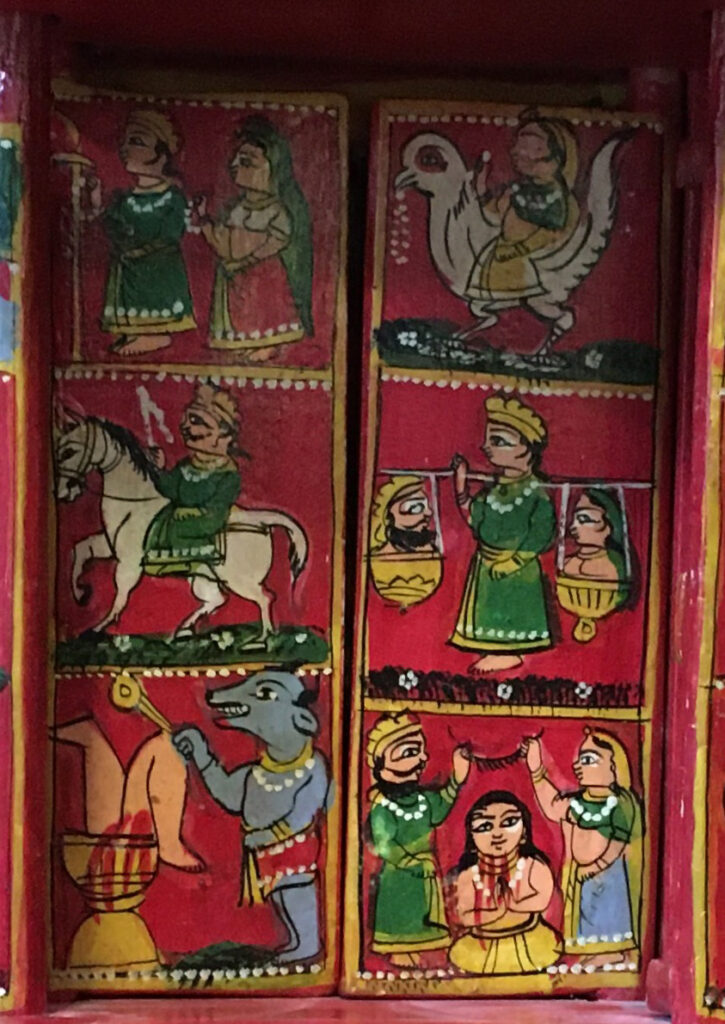
click for story details
Right Door Top – We cannot identify the story line in this picture.
On the right hand door in the middle is Ramdevji or Baba Ramdev a champion of the poor and needy whose Hindu followers are spread widely across India. He has a number of fairs dedicated to him in Rajasthan each year and is venerated throughout Pakistan by Muslims where he is a Sufi Saint known as Ramshah Pir or Rama Shah Peer.
A real life 14th Century ruler, there are also many legends about Ramdevji. Once five Pirs (Sufi spiritual guide) were sent from Mecca to test him. When they arrived he gave them a big welcome and invited them to eat with him, at first they refused telling him that they could only eat with their own utensils which were in Mecca. Ramdevji immediately brought their utensils flying through the air to them. They ate with him, paid homage to him and stayed with him until their death.
The right door bottom picture seems to be another story of a sinner receiving punishment in hell.
The left door top image is Behmata a Goddess who chooses children’s fates and foretells their futures. She is venerated in Northern India were she seems to be an alternative version of Mother Goddess Shashthi. Vishnu allowed Ravana to take Behmata to his palace at Lanka to massage his feet, but later, as the avatar Rama, freed her so she could return to heaven.
The left door middle image shows Shravan carrying his aged blind parents taking them on a pilgimage.
The left door bottom image – We cannot identify this story line.
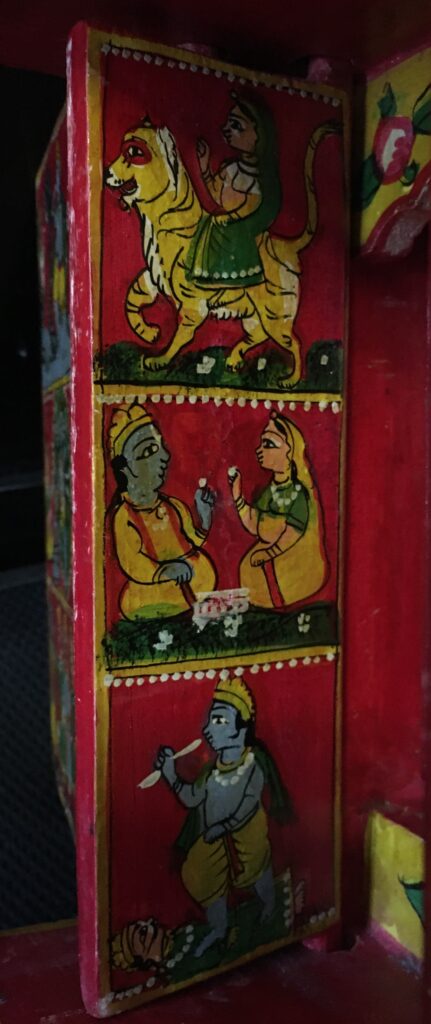
click for story details
Inside the left door, the picture at the top shows Durga Maa Sherawali riding on her lion. She is revered as a fierce killer of demons.
The middle picture possibly shows Karmabai feeding Krishna. When her father left her alone in their house he commanded her not to eat until she had offered the food to Lord Krishna. She took this rather literally and would not eat any food until Krishna ate first. Krishna witnessed her display of will and the fact that she would starve herself to death rather than take food before him so he visited her house and ate with her.
The bottom picture shows Krishna dancing on a King, we have not been able to identify the story it portrays.
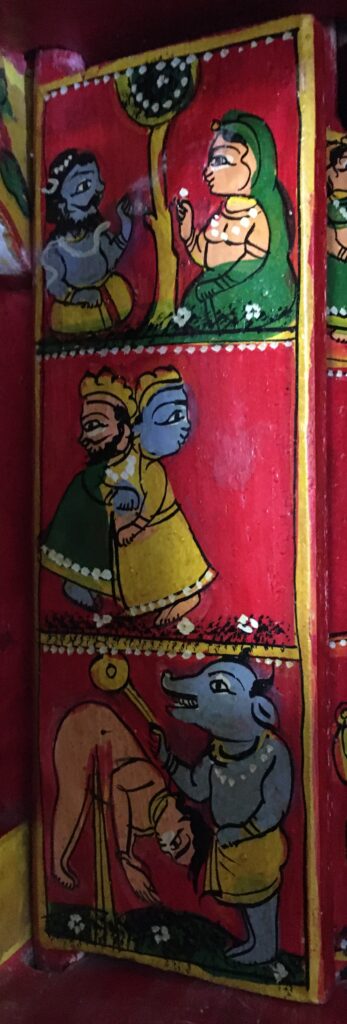
click for story details
On the inside of the right door on the top picture you can see yet another image of a young woman feasting under a tree with a god, possibly a repeat of the story of Shravat.
The middle picture shows Sudama meeting Krishna. Sudama was a childhood friend of Krishna who grew up and led a life of poverty. Eventually his wife persuaded him to go to see Krishna and ask for his blessing. When Sudama returned home he found that his hut had been transformed into a golden palace.
The bottom picture shows yet another sinner being punished by a demon in hell. This might be Dutibai, a childless woman who committed many sins in her life.
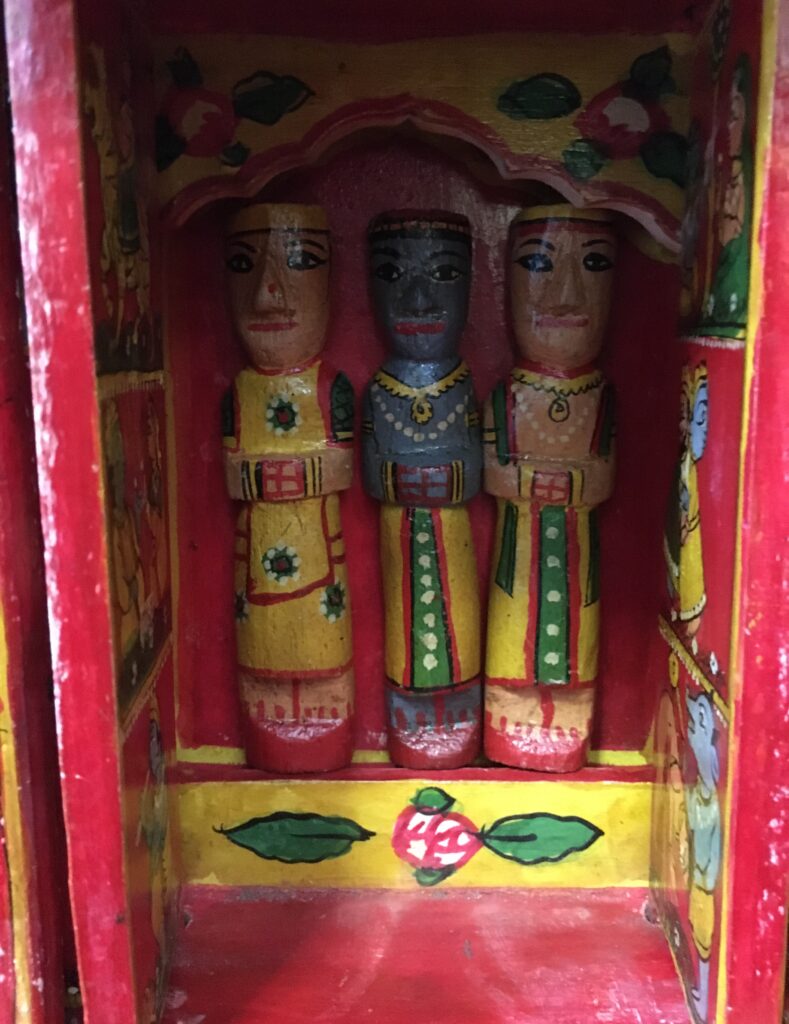
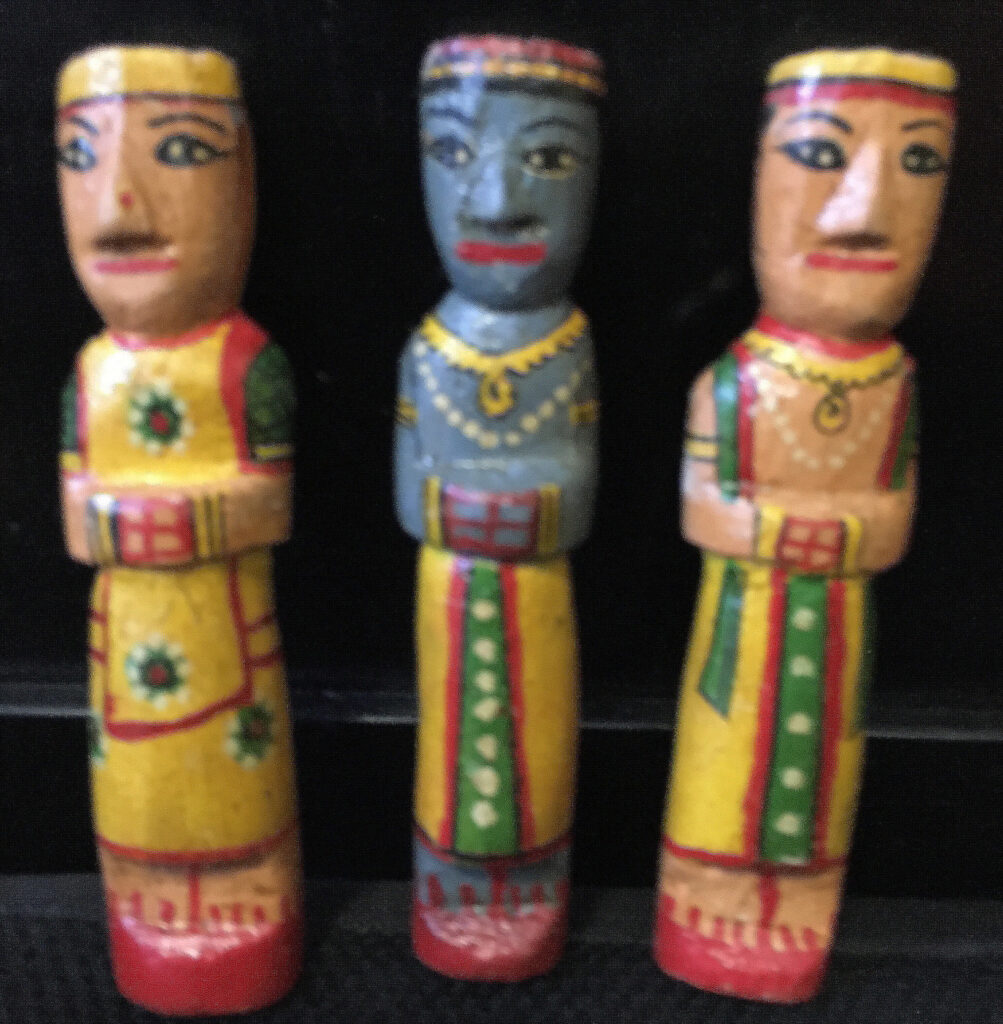
click for details
Finally, we get to the Inner Shrine and the three figures inside. Who are they? Helen East was told when she acquired the kaavad they were Krishna and two of his wives. The blue skinned God is definitely an avatar of Vishnu. However over the years of caring for the Kaavad and examining the dress code of the figures we believe they might be Rama, Sita and Lakshmana. What do you think?
Meeting these figures will definitely bestow a blessing on the storyteller’s audience whether it be his patron or the museum visitor.
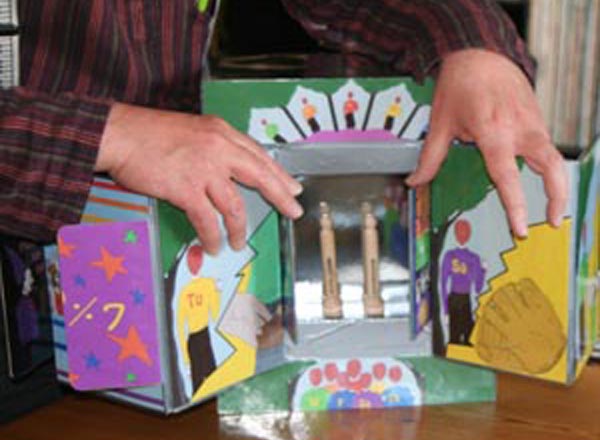
Mythstories saw the Kaavad as an ideal model to emulate for the telling of epic sagas and canonic legends such as King Arthur, Robin Hood etc. Elsewhere on the website you will find instructions on making your own Kaavad at https://mythstories.com/educational_resources/make-and-use-a-kavad/ and a creativity challenge to make your own Kaavad of King Arthur stories at https://mythstories.com/stories/lets-create-at-home-kavad/.
If you want to go into more depth on the Kaavad Tradition we would highly recommend the book “Kaavad Tradition of Rajasthan, A Portable Pilgrimage” by Nina Sabnani ISBN978-93-83098-32-3.
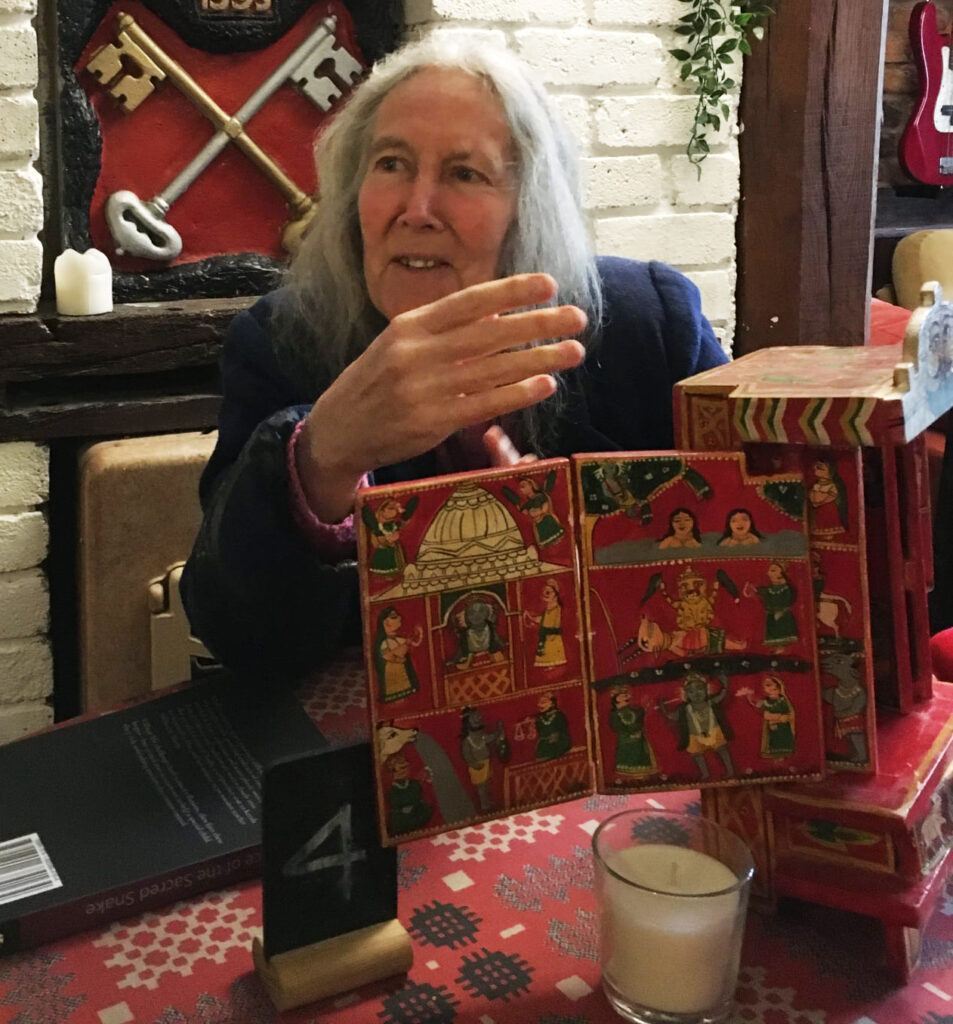
The Kaavad from Mythstories Collection has been returned to its owner, Helen East.

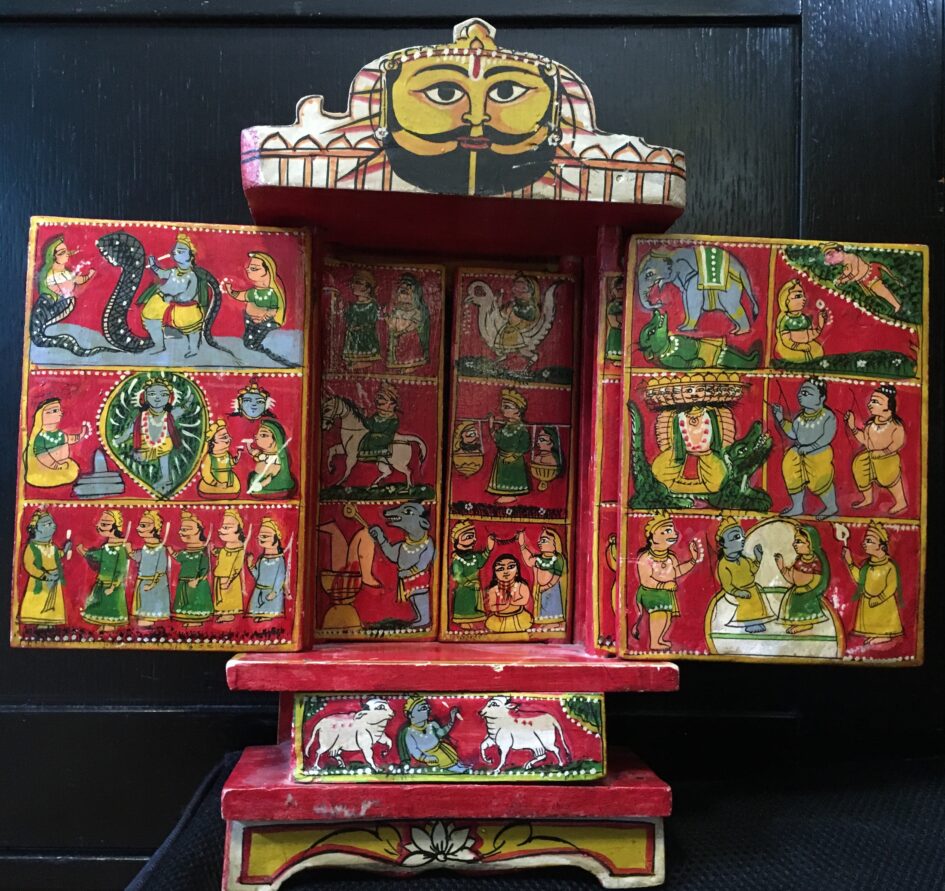


1 Pingback